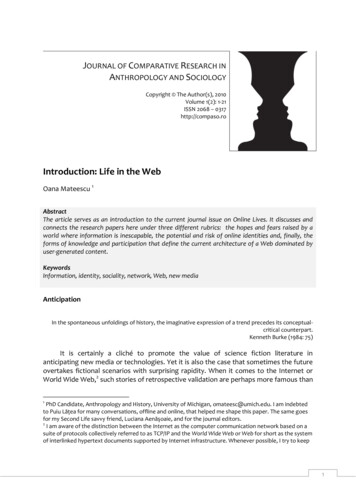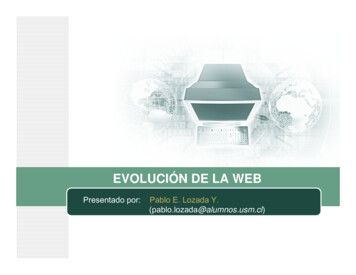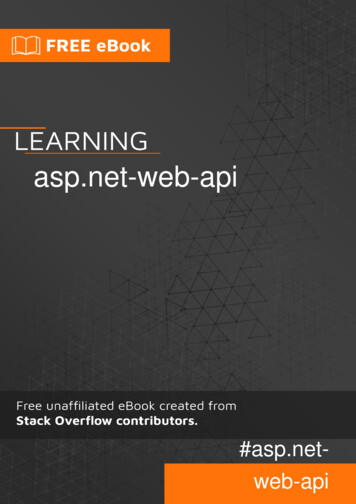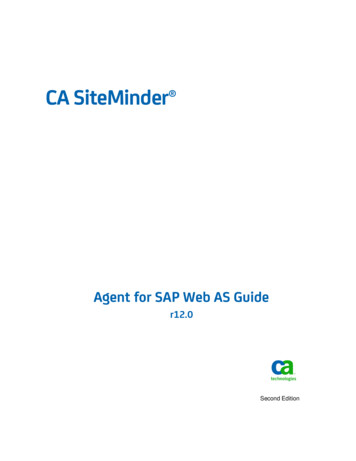
Transcription
JOURNAL OF COMPARATIVE RESEARCH INANTHROPOLOGY AND SOCIOLOGYCopyright The Author(s), 2010Volume 1(2): 1-21ISSN 2068 – 0317http://compaso.roIntroduction: Life in the WebOana Mateescu 1AbstractThe article serves as an introduction to the current journal issue on Online Lives. It discusses andconnects the research papers here under three different rubrics: the hopes and fears raised by aworld where information is inescapable, the potential and risk of online identities and, finally, theforms of knowledge and participation that define the current architecture of a Web dominated byuser-generated content.KeywordsInformation, identity, sociality, network, Web, new mediaAnticipationIn the spontaneous unfoldings of history, the imaginative expression of a trend precedes its conceptualcritical counterpart.Kenneth Burke (1984: 75)It is certainly a cliché to promote the value of science fiction literature inanticipating new media or technologies. Yet it is also the case that sometimes the futureovertakes fictional scenarios with surprising rapidity. When it comes to the Internet orWorld Wide Web,2 such stories of retrospective validation are perhaps more famous than1PhD Candidate, Anthropology and History, University of Michigan, omateesc@umich.edu. I am indebtedto Puiu Lățea for many conversations, offline and online, that helped me shape this paper. The same goesfor my Second Life savvy friend, Luciana Aenăşoaie, and for the journal editors.2I am aware of the distinction between the Internet as the computer communication network based on asuite of protocols collectively referred to as TCP/IP and the World Wide Web or Web for short as the systemof interlinked hypertext documents supported by Internet infrastructure. Whenever possible, I try to keep1
Journal of Comparative Research in Anthropology and Sociology, Volume 1, Number 2, Fall 2010others. Cyberpunk fans will immediately light on William Gibson’s Neuromancer (1984) orNeal Stephenson’s Snow Crash (1992), while SF connoisseurs will plead for John Brunner’sThe Shockwave Rider (1975) as an origin point for the imagination of informational websand virtual worlds avant la lettre. A more recent addition to this register is Charles Stross’Halting State (2007), a brilliant exploration of online gaming, virtual currencies, and thesecurity vicissitudes of a (very) near future Internet-mediated world. I use some tropes inhis novel to point to several critical connections discussed in this introductory articlebetween the hopes and fears raised by a world where information is inescapable, thepotential and risks of online identities and the forms of knowledge and participation thatdefine the current architecture of a Web dominated by user-generated content. Thesethree rubrics also serve to organize and put in conversation the nine research papers inthis issue.Halting State opens with the unusual heist of the valuables vault in a massivelymultiplayer online role-playing game (MMORPG) by a band of orcs with their pet dragon.It then unfolds as a police procedural featuring the forensic insurance investigator calledin by the financial institution backing the MMORPG assets in offline life, a gaming geekand virtuoso programmer as well as a host of rather unsavory characters bent either onworld domination or indecently rapid financial accumulation. Stross’ stroke of genius isthe invention of a live action role-playing game (LARP) that capitalizes on the glamour ofspying and intelligence gathering and is aptly called Spooks. What makes Spooksdifferent from the games we know is its uncannily clever knowledge infrastructure thatrelies on the unwitting recruitment of human intelligence agents who go aboutperforming what they believe are game tasks while at the same time fulfilling theintelligence or surveillance needs of various powers that be. As one character, part of anunnamed yet pervasive intelligence agency, puts it: “’Would you believe it used to cost usten thousand Euros a day to put a full surveillance team on a suspect? Now we've gotvolunteers who'll pay us to let them do our leg work!’ It's all mediated through artificialreality and live-action role-playing games like SPOOKS.”3Just as in the non-fictional world, the surfeit of information has undeniablepayoffs as well as unanticipated drawbacks. Stross imagines clever solutions for thelatter: those who can afford it can pay for the services of specialized cleaning companieswho manage, remove or re-prioritize the kinds of information that aggregate into youronline identity profile, protecting you from the lasting consequences of harmful bits ofdata. This future turns out to be already here: online identity clean-ups are now availablefrom a multitude of various companies that emerged in the last couple of years. A betterknown one is ReputationDefender which, by its very name, acknowledges the crucialthe two notions separate but sometimes stylistic and other reasons intervene to make theminterchangeable.3It is perhaps a sign of the Zeitgeist that William Gibson’s novel of intelligence games Spook Country (2007)came out the same year as Halting State. See Thompson (2006) on US intelligence agencies plans to switchto open-source spying and use Web 2.0 tools in the creation of an Intellipedia. See also the 2006 designproject Rewiring the Spy by Lisa Strausfeld and James Nick Sears (http://pentagram.com).2
Oana Mateescu / Introduction: Life in the Webimportance of online reputation as a resource, form of property and increasingly so, anew type of virtual currency (but more on this below). 4Throughout the novel, the reader is drawn into a world where the real and thevirtual are almost seamlessly integrated: the loss of virtual currency bankrupts offlinebanks, real life villains hide behind MMORPG characters and information is not onlypouring out of various handheld devices but is automatically projected on any kind oftangible flat surface, allowing you to inhabit a space where the online/offline distinctionis becoming meaningless. If such a digitalized reality seems far-fetched, think again. Justlast year, Pranav Mistry with the MIT Media Lab developed Sixth Sense, a wearable devicewhich, prompted by natural hand gestures, turns walls and other physical objects intoinstant digital interfaces, projecting on them all the information that was previouslyconfined to the screen. As Mistry claims, “it makes the entire world your computer.” 5In this sense, Halting State is significant because it combines, and plays with, twodifferent visions of what 21st century computer networks could become (toying also withthe limits of a universal Turing machine as the title pun shows). In a 1991 special issue ofScientific American, Mark Weiser at Xerox PARC articulated this difference as onebetween virtual reality and embodied virtuality. The first is the most familiar to nowadaysInternet users: it is the world built within the computer network, one of onlinecommunities, MMORPGs and Second Life(s). The second is the world of ubiquitous orinvisible computing, which Weiser promoted as a way of “disappearing technology” ormaking it “ready-to-hand” in phenomenological terms.6 One can also discern thebeginnings of ubiquitous computing in the increasing portability of communicationdevices, location-based applications such as Google Latitude and Facebook Places (thatprefigure theorized context-aware pervasive systems), wearable interfaces like SixthSense or hypothetical applications of nanotechnology such as smart dust.7 The Spooksgame is, in effect, the marriage of virtual reality with embodied virtuality.Ultimately, the distinction itself is not important. When Internet technologybecomes pervasively integrated, the notion of virtuality itself needs to be rethought. Forthe moment, we can use it in a temporally inflected narrative, as a future in the present, amode of anticipation that, paradoxically enough, trains us to deal with the unexpected.4http://www.reputationdefender.com/ (Last visited October 2010). In fact, ReputationDefender wasstarted up in 2006 and was already running by the time Stross’ novel was published. Online identitymanagement companies operate by tweaking the complex algorithms used by search engines (primarilyGoogle) in order to establish how web sites are ranked. The goal is to decrease the visibility of sitescontaining negative publicity for an individual or company and inversely to bring up to the top of the searchthose sites with positive hsense/#ABOUT (Last visited October 2010).6Weiser (1991) further develops this idea: “ubiquitous computers will help overcome the problem ofinformation overload. There is more information available at our fingertips during a walk in the woods thanin any computer system, yet people find a walk among trees relaxing and computers frustrating. Machinesthat fit the human environment, instead of forcing humans to enter theirs, will make using a computer asrefreshing as taking a walk in the woods.”7For science-fiction readers, the contrast between the world within the computer and the world made intoa computer could well be that of William Gibson’s Neuromancer (1984) versus Philip K. Dick’s Ubik (1969).3
Journal of Comparative Research in Anthropology and Sociology, Volume 1, Number 2, Fall 2010All the papers in this issue confront, in one way or another, with this shiftingconfiguration of media, story, identity and knowledge.Information (social) and Web 2.08Information used to be the scarce resource. Now attentionis the scarce resource. Whodini (2001)Digital technology has made it infinitely simpler to acquire, store, classify, manipulate andretrieve information. Yet, this very abundance raises its own problems of design,selection and control (Huberman 2001; Warner 2010). The above Whodini motto comesfrom the elusive and protean author of The Information Inferno, which is a “designerbook,” that rare species that tries to blend print and digital technologies to invent newforms of graphical expression, and by doing so to draw attention to the new “economyof attention” (Lanham 2006) governing the digital age. The current supply of informationis indeed staggering in its breadth, diversity, and temporal persistence. Scott Lash (2002:xii) has already put it famously: the “information order is inescapable” and it “gives us nolonger an outside place to stand.” The shortage now is in attention structures adjustedto digital rather than print forms of design and expression – or so at least goes theargument formulated by media historians (Crary 2000) and even a professor of rhetoriclike Richard Lanham.9To begin with, the rapid and dynamic pace of information growth on the Webmakes it increasingly difficult to search: by the time a search is completed, content orlinks might have changed into something different. Already in 1945, Vannevar Bush (2003[1945]) imagined the computer (the memex) as a revolutionary tool of informationretrieval, but it wasn’t until the late 1990s that this promise was realized with the designof search engines. The Web before Google was a labyrinth of information that inspiredpessimism in those observers interested in the economy of knowledge (Dreyfus 2001).Even so, current search engines cover only a fraction of the surface Web and are more orless powerless to explore the much larger Deep Web of proprietary databases,dynamically generated sites, limited access or unlinked content (Wright 2009).For some, such as co-inventor of the Web, Tim Berners-Lee and his World WideWeb Consortium (the main international standards organization for the Web), thesolution is to move already towards the future, which would be the Semantic Web. Ifcurrent search engines operate syntactically on the basis of algorithms that calculate thepopularity of web sites (for instance, Google’s PageRank), the ambitious Semantic Webproposes the creation of a machine-readable language, uniform and standardizedthroughout the Web, that would make it possible for computers to achieve at least a8I used a tag cloud generator to come up with the subtitle for this section - http://tagcrowd.com/ (Lastvisited October 2010). Word or tag cloud generators help one visualize the structure of a text, website ornetwork by giving more prominence to the most frequent words or tags.9Daniel Miller (2000) makes a similar point when analyzing the aesthetic form of Trinidadian websites as“attention traps” (apud Alfred Gell 1998).4
Oana Mateescu / Introduction: Life in the Weblimited understanding of the semantic content (that is, the meaning) of the informationthey are retrieving. “The Semantic Web will bring structure to the meaningful content ofWeb pages, creating an environment where software agents roaming from page to pagecan readily carry out sophisticated tasks for users” (Berners-Lee et all 2001). In otherwords, my future Semantic Web agent will be able to set up my doctor’s appointment,tell me what is the most popular restaurant among my closest Facebook friends or evencoordinate with my other digital devices (for instance, lowering the volume of my musicwhen the cell phone rings). To make such intelligent agents possible, the Web needs tobe redesigned in terms of a universal information architecture fostering automatedreasoning. This would not only include common metadata tags (eXtensible MarkupLanguage) and meaning structures (Resource Description Framework) but alsoontologies (for instance, the Web Ontological Language), that is collections ofinformation capable of expressing both classes of data and the relations among them,such as domain specific inference rules.10 Bringing universality and standardization to anysystem of knowledge representation makes it much easier to control (Bowker and Star1999) and so it is not very surprising that surveillance based institutions such as thePentagon are interested in Semantic Web applications.11 We tend to forget the extent towhich modern media are suffused with war (de Landa 1991) and that the Internet itselforiginated with the ARPANET from within the military-technological complex of the USDepartment of Defense (Abbate 1999).The difficulties of information retrieval and filtering coupled with the scarcity ofattention might arguably account for some of the findings presented in Laura Nistor’spaper in this issue on the role of the Internet in shaping environmental concerns. Nistoruses survey data (Special Eurobarometer 2007-2008) and statistical analysis toinvestigate the extent to which EU citizens are attuned to the Internet as a source ofenvironmental information and as a guide for environmentally sensitive attitudes andpractices. She discusses the common problems posed by the uneven geography ofbroadband Internet penetration as well as the more critical “digital divide” betweenpost-communist countries and the rest of the EU, which in turn are related to thesignificant differences in environmental concern between old and new members. One ofher important findings is that perceived levels of information on, or commitment toenvironmentalism, are not necessarily enhanced by specific Internet use (geared towardobtaining environmental information) but by regular surfing of the Internet. Everydaybrowsing, ordinary navigation of the Web apparently creates more opportunities forenvironmental sensitivity than specifically tailored searches or use patterns focused onenvironmental activism websites. As the author acknowledges, more research is neededon what forms specific Internet use takes, but perhaps also on how even the pathways ofgeneral Internet use are continuously shaped by the user’s participation in various onlinesocial media which already act as powerful information structuring devices.10For more detailed information see the W3C website at http://www.w3.org/2001/sw/ andhttp://semanticweb.org/wiki/Main Page (Last visited October 2010).11http://boingboing.net/2006/06/29/pentagon funding res.html (Last visited October 2010).5
Journal of Comparative Research in Anthropology and Sociology, Volume 1, Number 2, Fall 2010As the understanding of the Internet as an attention economy governed by thecurrency of “eyeballs,” page hits or “attention transactions” (which constitute the breadand butter of page ranking systems and search algorithms) came by, various observersclaimed to glimpse a new shape emerging out of Internet information architecture. Thisis the dynamic, interactive and social Web 2.0, dominated by user-generated content, theWeb of blogs, wikis, folksonomies (collections of tags that evolve into folk taxonomies),social networking sites (SNS), online games, virtual worlds, video and photo-sharingsites, tweets, etc. It is the Web where consumers are also producers, where users are notmerely readers of text but collaborative participants and sharers in the expansion of avast archive of information. It is a recent phenomenon – about five years old – thatgained even more momentum through the increasing portability and mobility ofcommunication tools: besides the computer accessible web, there are now mobilephones, PDAs, iPods, iPhones, wi-fi, etc. Here is how Wikipedia (itself a product of thiscollaborative landscape) presents Web 2.0:The term Web 2.0 is commonly associated with web applications that facilitateinteractive information sharing, interoperability, user-centered design, andcollaboration on the World Wide Web. A Web 2.0 site gives its users the free choiceto interact or collaborate with each other in a social media dialogue as creators(prosumer) of user-generated content in a virtual community, in contrast towebsites where users (consumer) are limited to the passive viewing of content thatwas created for them.12Web 2.0, the web of social media, is one in which “I care more about what myneighbor thinks than what Google thinks,” as pithily expressed by Eric Qualman inSocialnomics (2009), which is (enthusiastically) reviewed in this issue by MonicaCostache. In this view, information retrieval is always situated within a community ofpractice (network, if you will) in which the answers of friends and acquaintances aremore trustworthy than the relatively generic information provided by search engines.The best bookstore is the one recommended or highly reviewed by people I know andnot necessarily the one that is algorithmically placed at the top by Google. In the mostobvious cases, the actual work of information retrieval is outsourced to one’s friends viadirect questioning as happens on Twitter or Facebook. Less obviously but morepervasively, information is accessed via the tagging system initiated by socialbookmarking sites such as Delicious or Digg. Tags are user-created in order to identifyand categorize various types of content in a bottom-up, non-hierarchical, decentralizedconfiguration. Now they permeate almost all social software and have spontaneously12Wikipedia contributors, "Web 2.0," Wikipedia, The Free itle Web 2.0&oldid 394952816 (accessed November 5, 2010). While Imight have quoted any online encyclopedia, I chose Wikipedia to emphasize the enormous collaborativeand self-organizing work of dynamic knowledge production that is currently going on throughout the Web(see also O’Sullivan 2009).6
Oana Mateescu / Introduction: Life in the Webaggregated into so-called folksonomies that provide an easily accessible (albeitoverlapping) knowledge infrastructure. Social tagging and other instances ofcollaborative informational architectures (such as wikis) have inspired reneweddiscussion of the possibilities inherent in complexity theory and more particularly thefeatures of emergent orders, self-organization, autopoiesis and even biologicalcomputing and artificial life (Terranova 2004; Helmreich 2000; O’Sullivan 2009).Part of this collaborative culture are Internet talkbacks, explored here by BenAsher and Lebel’s paper on competing public representations of Israeli Defense Forces(IDF) widows. What the authors identify as talkbacks are forms of written feedbackposted by readers to news articles and that “read as a direct continuation of them,”becoming “part of the articles themselves” (p. 24). Congruent with other Web 2.0applications, talkbacks turn every reader into a writer who can comment, criticize, praiseor oppose – in short, undercut the formation of hegemonic discourses by a continuouslymaintained feedback loop. Ben-Asher and Lebel use talkback statements as the basis of aquestionnaire which explores reactions to IDF widows’ demands for continued statesupport even after they form a new intimate relationship. Statistical analysis of theresponses shows the articulation of two conflicting discourses – a republican-nationalistone that conditions state recognition on widows’ not remarrying and a liberalemancipated one that favors the rehabilitation of widows, treating them as individualsrather than national symbols of commemoration – as well as a third polemical discoursethat underlines the incommensurability of the previous two. By the design of theirresearch, the two authors treat talkbacks as static snippets of public opinion, decontextualizing them from the specific setting of their production. This is important tothe extent that talkbacks are highly indexical: they talk not only to the article they areposted on but also to each other, weaving their own pattern of meaning. Ben-Asher andLebel rightly explore them as instances of “authentic” public discourse, but thisauthenticity is itself mediated, by the collaborative framework of the Web in general aswell as by the situated conversational structures that talkbacks are embedded in.Ultimately, the question arises whether talkbacks as instances of oppositional discourseare also portable, that is capable of maintaining whatever impact they have outside theircontext of production.Such issues of portability come up whenever enthusiastic supporters of socialmedia emphasize their potential for social and political change, both online and offline.There are the already media famous “Twitter revolutions,” one in Moldova in the springof 2009, the other in Iran a few months after. To paraphrase the old Radio Erevan jokespopular in communist Eastern Europe, these were indeed Twitter revolutions, only in theabsence of Twitter and without revolution. As Malcolm Gladwell (2010) points out, therevolutions were actually various forms of organized protest; as for Twitter, there werevery few accounts in Moldova itself (Morozov 2009) while the Iran-related conversationswere mostly carried out in English by émigré communities (Esfandiari 2010). In the wordsof the manager of a popular Farsi language website: “most of it is Americans tweetingamong themselves” (Esfandiari 2010).7
Journal of Comparative Research in Anthropology and Sociology, Volume 1, Number 2, Fall 2010It is undeniable that social media are powerful instruments of public visibility and,even more importantly, of real-time coordination, side-stepping physical spaceconstraints (see for instance Rafael 2005 on cell phones in Philippines). Even so, Gladwell(2010) notes with wry irony, “Where activists were once defined by their causes, they arenow defined by their tools.” Gladwell is deeply suspicious of the power of networks toachieve lasting change and confront high-risk situations. In his opinion, hierarchy isultimately indispensable; loose ties and consensus-based decisions will simply not cut it inthe face of real danger. And yet, his alternative activism illustration comes from the1960’s civil rights movement in the US, in a media landscape very different from thecurrent one. From this point of view, Evegeny Morozov (2009), the initiator and defenderof the Moldova Twitter revolution meme (as he styles himself), is right to point out thatthe low number of Twitter accounts in Moldova (around 70) is not relevant in itself; whatcounts is that those accounts give one access to a Twitter network that is itselfconnected to dozens other networks: “on a good network, you don't need to have themaximum number of connections to be powerful -- you just need to be connected toenough nodes with connections of their own.” This is indeed a good illustration ofnetwork efficiency, particularly in what regards the transmission of a meme. But therapid circulation of a hashtag within and without Twitter is in the end proof of just that:networks enable, track and reference, circulation better than most other informationarchitectures. The extent to which they can interoperate with more hierarchicalstructures (especially offline ones) is still up for debate. In the Morozov case, it is doublyironic that the meme should come back to haunt its creator: first, because the very ideaof authorship ought to be theoretically irrelevant in the distributed structure of thenetwork; second, because it shows how network connectivity is ultimately powered byself and self-referentiality.As the 2006 Time Person of the Year (You) showed, the explosion of social mediafacilitates and even demands the production of self-oriented information. Laura Arosio’spaper in this issue deals precisely with this emerging landscape of personal documentson the Web. Arosio distinguishes between sociology with the Internet (as a datacollection tool) and sociology on the Internet (as a documentary archive), focusing onthe latter and on how to better collect, contextualize and analyse personal documentssuch as e-mails, forums, blogs, personal sites and online visual albums. Arosio is deeplysensitive to the situated nature of such documents, reflecting on the complications thatarise due to different levels of computer literacy, the temporality of production, forms ofauthorship that are not tied to stable identities, privacy configurations or linguisticnuances and emerging codes of online communication. In this context, it is somewhatsurprising that she attempts to establish equivalence relations between traditionalpersonal documents and web-mediated ones (such as letter/e-mail, diary/blog,autobiography/personal site). By doing so, Arosio alludes to, but narrowly misses, severalimportant questions about the relations between old and new media.One can imagine the multiple genealogical relations that connect print and digitaldocuments, but equivalence downplays the situated nature of their different mediations.The question here is whether such analogies help us to better understand the8
Oana Mateescu / Introduction: Life in the Webproliferation and features of personal digital documents. They might point to thepersistence or even path-dependency of information design and infrastructure: withsome exceptions, e-books nowadays are rather consistent replicas of traditional printbooks with little attempt to exploit the possibilities of digital expression (Lanham2006).13 Perhaps such continuities are nothing to wonder at: the first book to come outof Gutenberg’s press, the 42-line Bible, was “indistinguishable at first sight from anilluminated manuscript” (Clanchy 1993: 279). Alternatively, it might be that the veryprocess of self-memorialization on the Web is rooted in the archival imaginary firstopened up by writing technology and further extended by printing, photography andmechanical sound recording (Chun and Keenan 2005; Gitelman 2006; Kittler 1999). In thissense, the digital archive trumps all others, given its virtually unlimited storagecapabilities and its mnemonic potential. Finally, as Arosio notes, digital personaldocuments are deeply relational, embedded as they are in the collaborative structure ofsocial media. Thus, if blogs or personal sites embody subjectivity and memorialize theself, what kinds of selves and subjectivities are we really talking about?Ident(ification)The technologies of today have none of the integrity of thetechnologies of 1984. None are decent enough to letyou know when your life is being recorded. Lawrence Lessig (2006: 209)Copying and reproduction produce individuality by limitingreplication. Valentin Groebner (2007: 238)Whenever you make a search on Google, it is logged and stored in a vast archive ofcuriosity and can be traced back to your IP address (unless you take precautionaryprivacy measures). Similarly, unless you disable your cookies, you allow websites tomonitor and track you and even to exchange data about you with other partnerwebsites. The old Internet network based on the minimalist end-to-end principle wasdesigned to ensure anonymity but subsequent digital infrastructures such as cookies andcryptographic techniques of authentication make identification the default option. This isa familiar story of increasing control, inevitable identification and quasi-unlimitedpotential for surveillance - one which Internet law expert Lawrence Lessig (1999; 2006)traces with unusual clarity.In 1999, Lessig declared in the first edition of his famous book, Code: “We will seethat cyberspace does not guarantee its own freedom but instead carries an extraordinarypotential for control.” By the time the second edition came out in 2006, he gave free reinto his circumspect pessimism: “Whether cyberspace can be regulated depends upon itsarchitecture. The original architecture of the Internet made regulation extremelydifficult. But that original architecture can change. ( ) Indeed, under the architecture13See however the ongoing projects and discussions on this topic initiated by the Institute for the Future ofthe Book, http://www.futureofthebook.org/ (Last visited October 2010).9
Journal of Comparative Research in Anthropology and Sociology, Volume 1, Number 2, Fall 2010that I believe will emerge, cyberspace will be the most regulable space humans have everknown” (Lessig 2006: 33).This is not a promising beginning for a discussion of those papers in this issue thatextol the potential of the Web for the experimental articulation of identities. Yet, Ichoose to frame my comments this way precisely to make
connects the research papers here under three different rubrics: the hopes and fears raised by a world where information is inescapable, the potential and risk of online identities and, finally, the . s that this promise was realized with the design of search engines. The Web before Google was a labyrinth of information that inspired











